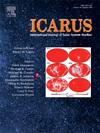拉塞尔地块火山爆发:月球硅火山作用的启示
IF 3
2区 物理与天体物理
Q2 ASTRONOMY & ASTROPHYSICS
引用次数: 0
摘要
火山活动表现为平静的喷发或剧烈的爆发,这取决于大气中的气体含量和水的相互作用。由于缺乏大气和水,月球上的火山爆发受到限制;然而,最近的遥感和数值模拟结果表明,月球过去可能是湿润的,因此影响了火山爆发的形式。在这项工作中使用了月球形态、光谱和重力数据。利用氧化物含量反演模型和三维密度反演模型对拉塞尔地块的地形、化学成分和地下结构进行的研究表明,爆炸性火山爆发确实发生在月球上。在拉塞尔地块北部下方发现了一个负椭球密度异常,其值为~ - 230.5 kg/m3,表明它是一个硅质岩浆房。此外,对该地区地形和化学成分的调查表明,岩浆是向南喷出的。这项研究为月球上可能存在内生水或其他挥发性物质提供了启发性的见解。未来,与硅火山活动有关的地点将成为进一步月球内源水调查的首选目标。本文章由计算机程序翻译,如有差异,请以英文原文为准。
Explosive volcanic eruption at Lassell Massif: Implications for lunar silicic volcanism
Volcanism manifests as either calm effusive or violent explosive eruptions depending on the gas content of the atmosphere and water interactions. Explosive volcanic eruptions on the Moon are limited by the lack of atmosphere and water; however, recent remote sensing and numerical modeling results suggest that the Moon may have been wet in the past, and thus influenced the form of volcanic eruptions. Lunar morphology, spectral and gravity data are used in this work. Investigations of the topography, chemical composition, and subsurface structure of the Lassell Massif using an oxide content inversion model and a three-dimensional density inversion model reveal that explosive volcanic eruptions did in fact occur on the Moon. A negative ellipsoidal density anomaly with a value of ∼ − 230.5 kg/m3 was identified beneath the northern portion of the Lassell Massif, suggesting that it is a silicic magma chamber. Furthermore, an investigation of the topography and chemical composition of the area shows that magma was ejected to the south. This research provides suggestive insights into the possible presence of endogenic water or other volatile species are present on the Moon. In the future, locations associated with silicic volcanism will be the preferred targets for further lunar investigations of endogenous water.
求助全文
通过发布文献求助,成功后即可免费获取论文全文。
去求助
来源期刊

Icarus
地学天文-天文与天体物理
CiteScore
6.30
自引率
18.80%
发文量
356
审稿时长
2-4 weeks
期刊介绍:
Icarus is devoted to the publication of original contributions in the field of Solar System studies. Manuscripts reporting the results of new research - observational, experimental, or theoretical - concerning the astronomy, geology, meteorology, physics, chemistry, biology, and other scientific aspects of our Solar System or extrasolar systems are welcome. The journal generally does not publish papers devoted exclusively to the Sun, the Earth, celestial mechanics, meteoritics, or astrophysics. Icarus does not publish papers that provide "improved" versions of Bode''s law, or other numerical relations, without a sound physical basis. Icarus does not publish meeting announcements or general notices. Reviews, historical papers, and manuscripts describing spacecraft instrumentation may be considered, but only with prior approval of the editor. An entire issue of the journal is occasionally devoted to a single subject, usually arising from a conference on the same topic. The language of publication is English. American or British usage is accepted, but not a mixture of these.
 求助内容:
求助内容: 应助结果提醒方式:
应助结果提醒方式:


